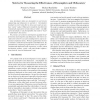Free Online Productivity Tools
i2Speak
i2Symbol
i2OCR
iTex2Img
iWeb2Print
iWeb2Shot
i2Type
iPdf2Split
iPdf2Merge
i2Bopomofo
i2Arabic
i2Style
i2Image
i2PDF
iLatex2Rtf
Sci2ools
IWPC
2007
IEEE
2007
IEEE
Metrics for Measuring the Effectiveness of Decompilers and Obfuscators
Java developers often use decompilers to aid reverse engineering and obfuscators to prevent it. Decompilers translate low-level class files to Java source and can produce “good” output. Obfuscators transform class files into semantically-equivalent versions that are either: (1) difficult to decompile, or (2) decompilable, but result in “hardto-understand” Java source. We present a set of metrics developed to quantify the effectiveness of decompilers and obfuscators. The metrics include some selective size and counting metrics and an expression complexity metric. We have applied these metrics to evaluate a collection of decompilers and obfuscators. By quantitatively comparing original Java source against decompiled and obfuscated code respectively, we show which decompilers produce “good” code and whether obfuscations result in “hard-to-understand” code.
| Added | 04 Jun 2010 |
| Updated | 04 Jun 2010 |
| Type | Conference |
| Year | 2007 |
| Where | IWPC |
| Authors | Nomair A. Naeem, Michael Batchelder, Laurie J. Hendren |
Comments (0)

